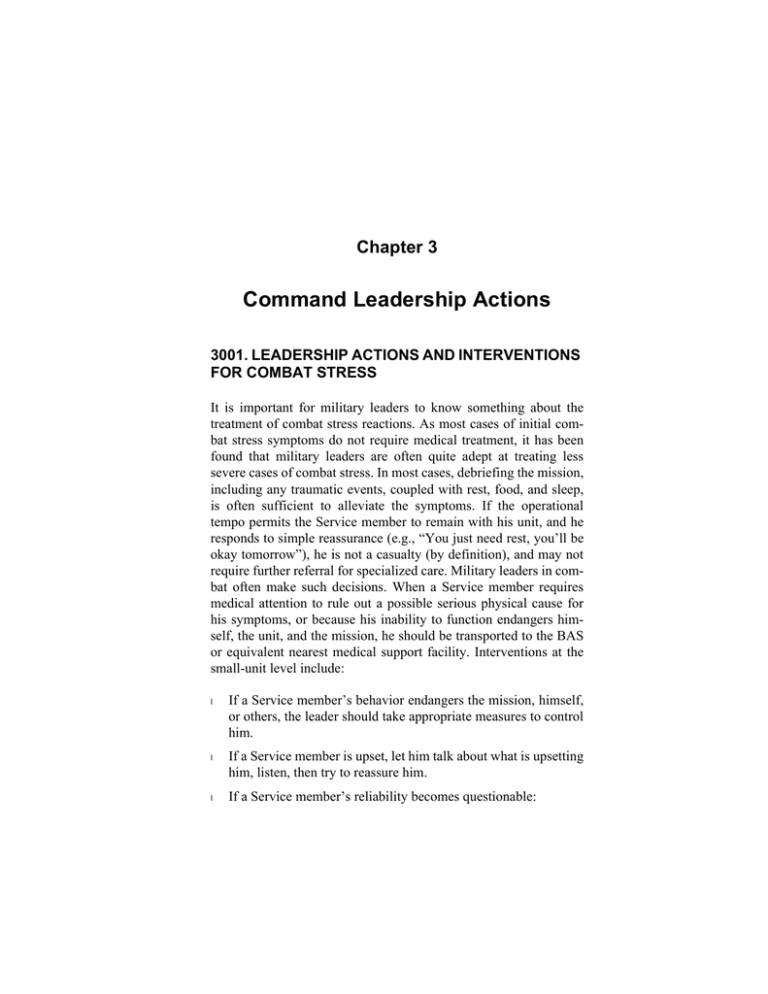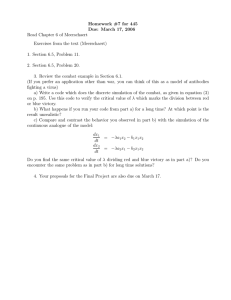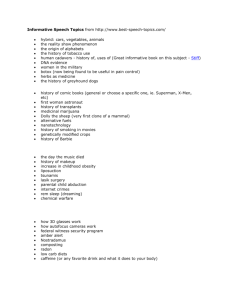Command Leadership Actions Chapter 3 3001. LEADERSHIP ACTIONS AND INTERVENTIONS FOR COMBAT STRESS
advertisement

Chapter 3 Command Leadership Actions 3001. LEADERSHIP ACTIONS AND INTERVENTIONS FOR COMBAT STRESS It is important for military leaders to know something about the treatment of combat stress reactions. As most cases of initial combat stress symptoms do not require medical treatment, it has been found that military leaders are often quite adept at treating less severe cases of combat stress. In most cases, debriefing the mission, including any traumatic events, coupled with rest, food, and sleep, is often sufficient to alleviate the symptoms. If the operational tempo permits the Service member to remain with his unit, and he responds to simple reassurance (e.g., “You just need rest, you’ll be okay tomorrow”), he is not a casualty (by definition), and may not require further referral for specialized care. Military leaders in combat often make such decisions. When a Service member requires medical attention to rule out a possible serious physical cause for his symptoms, or because his inability to function endangers himself, the unit, and the mission, he should be transported to the BAS or equivalent nearest medical support facility. Interventions at the small-unit level include: l If a Service member’s behavior endangers the mission, himself, or others, the leader should take appropriate measures to control him. l If a Service member is upset, let him talk about what is upsetting him, listen, then try to reassure him. l If a Service member’s reliability becomes questionable: 48 _______________________________________________ MCRP 6-11C n Unload the Service member’s weapon. n Remove the weapon if there is a serious concern. n Physically restrain the Service member only when safety is a concern or during transport. l Reassure unit members that the signs are probably a normal combat stress reaction, and will quickly improve. l If the combat stress reaction signs continue: n Get the Service member to a safer place. n Do not leave the Service member alone. Keep someone he knows with him. n Notify the senior NCO or officer. n Have the Service member examined by medical personel. l If the tactical situation permits, give the Service member simple tasks to do when not sleeping, eating or resting. l Assure the Service member that he will return to full duty as soon as possible. The following quote was taken from an article about fear. It was written by a Marine who articulated his experiences during his tours in Vietnam. It provides intricate insight into how many Service members think and bond during combat. What should be done when men succumb to fear brought on by the realization that they are going to die? Before discussing this, first let us look at the men themselves. There are very few men who can be classified as cowards. Most men have too much self-respect to let their buddies down. It is the rare man indeed who will willingly violate the trust of his peers. The vast majority of men will give their lives rather than violate this trust. Proper training of combat troops, prudent leaders who are technically and tactically sound, and the reluctance of men to violate the trust of their peers are the foundation Combat Stress _____________________________________________ 49 of a solid combat unit. In this environment, courage and sacrifice are the rule, not the exception. At any given moment, anyone can be rendered ineffective by fear if one realizes that he is going to die. When this happens to a man, do not overreact. He knows he has let his buddies down, and he knows that his buddies and leaders know he has let them down. This is a very uncomfortable feeling for a combat Marine. The men around him will not make a big deal about his actions because they understand the situation. To make an issue of this situation will destroy the man and usually alienate the rest of your men. The man will most likely bounce back to his normal performance. The leader must keep in mind that today's coward is tomorrow’s hero. If a man does not bounce back and continues to succumb to this type of fear, the Marines in his fire team will let you know when they have given up on him and no longer consider him trustworthy. Situations such as this are rare, so there is no need to make an example of the man. The biggest pitfall to be avoided is to judge the man's actions as a failure of your leadership as this will indeed cause you to overreact. 3002. SAFETY CONSIDERATIONS Confiscation of a Service member's weapon should only be considered when it is clearly apparent that the Service member is unreliable and a safety hazard to himself or others. Service members identify with other Service members who are trusted and needed by their comrades. This is one of the strongest factors that aid in returning battle-fatigued members to effective duty. The small-unit leader relocates battle-fatigued Service members to a safer, quieter place to rest and work for several hours up to 1 or 2 days. If the unit cannot wait for the Service members to recover, it is necessary to evacuate them to the first level supporting medical unit. From there, every effort is made to move the Service members to a nonmedical unit or area (a tent or building of opportunity could suffice) for rest, replenishment, and reassur- 50 _______________________________________________ MCRP 6-11C ance. It should be made clear that the Service members are tired and in need of an opportunity to talk, to sleep, eat, and replenish fluids; they are not patients. Some small detachments without first sergeants or platoon/company organizations are attached to other units for support and rely on the effectiveness of small-unit leaders. Each Service member is accounted for and every effort is made to ensure strong lines of communications are in place and maintained between Service members and their original unit. Key to successful treatment is the return of the Service member to his original unit. Actions to be taken for severely combat-stressed Service members are the same as those for the moderately combat-stressed, with one exception: medical personnel at the BAS level should evaluate severely combat-stressed Service members as soon as possible. Casualties will be treated and released within hours; held for rest and replenishment; or evacuated for further restoration. Service members who recover from combat stress reactions; return to their original units, i.e., same company or platoon; and are welcomed upon their return are less likely to suffer recurrence. Once rested and returned, they usually become healthy again. New joins and replacements in the unit are more susceptible to succumb to combat stress. Accordingly, this risk is reduced when Service members recovering from combat stress return to the same unit where their combat experience is known and welcomed. In rare instances, however, it is in the best interest of the individual to be reassigned to other jobs or units. Combat Stress _____________________________________________ 51 3003. COMBAT STRESS CASUALTY INTERVENTION MODELS Management of combat stress reactions is unlike the treatment of physical trauma. Severely injured Service members are stabilized as rapidly as possible and then transferred to the rear. In all wars since World War I, combat stress casualties treated in the rear rarely return to full duty. In contrast, when the same casualties are treated near the front, approximately 75 percent return to full duty. Of those returned to full duty, only 10 percent experience continued symptoms requiring further treatment. Some studies suggest half of those treated at the rear go on to have chronic psychiatric symptoms, and approximately half return to full duty. Therefore, it is clearly in the Service member's best interest to be treated at the front and returned to duty. This also serves the best interest of the unit because it receives a veteran Service member back to duty, rather than breaking in a replacement. Guidelines for dealing with Service members unable to function because of combat stress reaction are summarized in the memory aid BICEPS. BICEPS stands for brevity, immediacy, centrality (Marines)/command contact (Army), expectancy, proximity, and simplicity. l Brevity. Critical Event Debriefing should take 2 to 3 hours. Initial rest and replenishment at medical CSC facilities should last no more than 3 or 4 days. Those requiring further treatment are moved to the next level of care. Since many require no further treatment, military commanders expect their Service members to return to duty rapidly. l Immediacy. CSC should be done as soon as possible when operations permit. Intervention is provided as soon as symptoms appear. 52 _______________________________________________ l Centrality (Marines)/Contact (Army). Service members requiring observation or care beyond the unit level are evacuated to facilities in close proximity to, but separate from the medical or surgical patients at the BAS, surgical support company in a central location (Marines) or forward support/division support or area support medical companies (Army) nearest the service members' unit. It is best to send Service members who cannot continue their mission and require more extensive respite to a central facility other than a hospital, unless no other alternative is possible. The Service member must be encouraged to continue to think of himself as a warfighter, rather than a patient or a sick person. The chain of command remains directly involved in the Service member's recovery and return to duty. The CSC team coordinates with the unit's leaders to learn whether the overstressed individual was a good performer prior to the combat stress reaction, or whether he was always a marginal or problem performer whom the team would rather see replaced than returned. Whenever possible, representatives of the unit, or messages from the unit, tell the casualty that he is needed and wanted back. The CSC team coordinates with the unit leaders, through unit medical personnel or chaplains, any special advice on how to assure quick reintegration when the Service member returns to his unit. l Expectancy. The individual is explicitly told that he is reacting normally to extreme stress and is expected to recover and return to full duty in a few hours or days. A military leader is extremely effective in this area of treatment. Of all the things said to a Service member suffering from combat stress, the words of his small-unit leader have the greatest impact due to the positive bonding process that occurs during combat. Simple statements from the small-unit leader to the Service member that he is reacting normally to combat stress and is MCRP 6-11C Combat Stress _____________________________________________ 53 expected back soon have positive impact. Small-unit leaders should tell Service members that their comrades need and expect them to return. When they do return, the unit treats them as every other Service member and expects them to perform well. Service members suffering and recovering from combat stress disorder are no more likely to become overloaded again than are those who have not yet been overloaded. In fact, they are less likely to become overloaded than inexperienced replacements. l Proximity. In mobile war requiring rapid and frequent movement, treatment of many combat stress cases takes place at various battalion or regimental headquarters or logistical units, on light duty, rather than in medical units, whenever possible. This is a key factor and another area where the small-unit leader helps in the treatment. CSC and follow-up care for combat stress casualties are held as close as possible to and maintain close association with the member’s unit, and are an integral part of the entire healing process. A visit from a member of the individual’s unit during restoration is very effective in keeping a bond with the organization. A Service member suffering from combat stress reaction is having a crisis, and there are two basic elements to that crisis working in opposite directions. On the one hand, the Service member is driven by a strong desire to seek safety and to get out of an intolerable environment. On the other hand, the Service member does not want to let his comrades down. He wants to return to his unit. If a Service member starts to lose contact with his unit when he enters treatment, the impulse to get out of the war and return to safety takes over. He feels that he has failed his comrades and they have already rejected him as unworthy. The potential is for the Service member to become more and more emotionally invested in keeping his symptoms 54 _______________________________________________ MCRP 6-11C so he can stay in a safe environment. Much of this is done outside the Service member's conscious awareness, but the result is the same. The more out of touch the Service member is with his unit, the less likely he will recover. He is more likely to develop a chronic psychiatric illness and get evacuated from the war. This is one of the essential principles of CSC. l Simplicity. Treatment is kept very simple. CSC is not therapy. Psychotherapy is not done. The goal is to rapidly restore the Service member’s coping skills so that he functions and returns to duty again. Sleep, food, water, hygiene, encouragement, work details, and confidence-restoring talk are often all that is needed to restore a Service member to full operational readiness. This can be done in units in reserve positions, logistical units or at medical companies. Every effort is made to reinforce Service members’ identity. They are required to wear their uniforms and to keep their helmets, equipment, chemical protective gear, and flak jackets with them. When possible, they are allowed to keep their weapons after the weapons have been cleared. They may serve on guard duty or as members of a standby quick reaction force. If treated near their units, 65 to 85 percent of combat stress casualties treated in medical CSC facilities return to duty within 1 to 3 days. About 15 to 20 percent more return to duty in 1 to 2 weeks. Only 5 to 10 percent are sent home, and these usually have other problems in addition to combat stress reactions. If evacuated, few combat stressed Service members will return to duty. In fact, many are likely to be permanently disabled. History shows that it is important to treat combat stress casualties as close to the front as practicable. Everyone is susceptible to the effects of combat stress, regardless of past performance, rank or duty. Most Service members receiving combat stress control in Combat Stress _____________________________________________ 55 accordance with the principles of BICEPS return to duty quickly. The chances of later psychiatric problems are also reduced. Combat stress reactions are inevitable in combat, but high stress casualties are not. History shows that highly trained and small cohesive units with good leadership have less than 1 such casualty for every 10 to 15 WIA, even in very heavy fighting. This is significantly fewer than the usual 1:3 to 1:5 ratio in high-intensity battle, and the 1:1 or 1:2 ratio in extreme fighting. Knowledge of factors that increase combat stress disorder in the tactical and overall situation encourages small-unit leaders, comrades, and the individual Service member to act towards building unit cohesion, sharing the burden, and reducing stress. The same measures, plus positive adherence to discipline and the law of war, also prevent combat stress-related misconduct that defeats the purpose of the mission. Tough, realistic training that builds confidence and caring within the unit in combat overcomes many adversities associated with combat stress in a combat environment. However, if a member fails to adequately respond to actions taken by the unit, then he should be evacuated for appropriate medical evaluation.






